Abstract
The optimum tuning of the natural frequency and damping ratio of TMDs for structural modal parameters and various optimization criteria are well-known from the literature. However, when the eigenfrequency and modal mass of the target structural mode are uncertain due to estimation and measurement errors, significant life loads, temperature, and other time-varying effects, the existing TMD tuning rules are not necessarily optimal. An often-adopted method is to select the TMD damping ratio that is greater than optimal value to make the TMD less sensitive to variations of the target eigenfrequency and uncertainty in the modal mass. This heuristic approach is quantitatively investigated by the presented research. Computations are made for different TMD mass ratios, different uncertainties in target eigenfrequency and modal mass, different levels of increased TMD damping, and assuming harmonic excitation. The results demonstrate that there is no simple rule when increased TMD damping is advantageous. Therefore, beneficial TMD increase factors are given as functions of TMD mass ratio and deviations between actual and nominal modal structural properties. These data can be used by engineers for real TMD projects with uncertain modal parameters.
1. Introduction
The Tuned Mass Damper (TMD) is a very well-known vibration absorber that is installed in various structures such as bridges and tall buildings to mitigate structural vibrations [1,2]. The principles and optimum tuning rules for minimum structural displacement and harmonic excitation are described in Den Hartog’s book [3], which is based on the undamped dynamic vibration absorber invented by Frahm [4] and includes the damping tuning proposed by Brock [5]. Since then, numbers of papers have been published dealing with the optimum design of TMD natural frequency and damping for various optimization functions, i.e., the minimization of structural displacement, velocity, and acceleration, for harmonic and white noise excitations, for damped structures and base excited structures [6,7,8,9,10,11,12,13,14,15,16,17,18,19]. Common to all these studies is that the parameters of the target structural mode, i.e., eigenfrequency and modal mass, are assumed to be known quantities. However, this is not the case in reality. The modal parameters may significantly vary over time due to temperature effects on the structure, time-varying life loads, the relationship between structural damping and vibration amplitude, and unknown boundary conditions [20,21,22,23,24,25,26,27]. The reported variations of the observed eigenfrequencies reach up to ±9% [21] and change with temperature and load as described in [23] for a bell tower. The difference between the actual modal mass, which can only be determined with the use of numerous accelerometers to ensure the high spatial resolution of the mode shape of interest, and the modal mass derived from simple harmonic mode shape functions or those computed by the finite element model, may be up to 12% according to [27], who analyzed a conveyer belt bridge.
If modal parameters are expected to significantly change over time due to the aforementioned effects, or if they are simply unknown because they are not precisely measured, the following two concepts exist: Passive TMDs can be replaced by controlled TMDs [28,29,30,31,32], where natural frequency and damping are adjusted to the actual structural modal properties in real-time, or the damping of the passive TMD is selected to be a greater-than-optimal value. The latter approach is often adopted in practice; although, theoretical evidence is missing so far. This paper aims to answer the following questions: In which cases the concept of increased TMD damping is beneficial and by how much the actual TMD damping should be selected greater than the optimum solution, which is valid when modal parameters are precisely known. To achieve this goal, the vibrations of the primary structure with TMD are computed for typical TMD mass ratios, for reasonable uncertainty ranges of eigenfrequency and modal mass, and for different levels of increased TMD damping ratios. Mistuning of the TMD natural frequency and TMD damping ratio is not considered because the precise tunings of TMD natural frequency and TMD damping ratio are feasible with appropriate methods. The natural frequency can be optimized by adjusting the pendulum length or the number of springs, the oil damper viscous coefficient can be optimized by a bypass valve in the cylinder, etc. The evaluation of the results reveals when and how much increased TMD damping is beneficial depending on TMD mass ratio and the deviation between nominal and actual modal structural properties.
2. Modelling
2.1. Equations of Motion
The mitigation efficiency of a TMD is computed for the targeted modal component of the primary structure because TMDs are efficient in one modal component only [3,6,7,8,9,10,11,12]. The equations of motion of the primary structure in modal coordinates with TMD are shown as follows:
where denote the acceleration, velocity, and displacement of the primary structure relative to inertial system; is the absolute acceleration of the TMD mass; and are the TMD relative velocity and TMD relative displacement; describes the actual structural modal mass; and are the viscous damping and stiffness coefficients of the primary structure; denotes the excitation force; and describe the TMD mass, TMD viscous damping coefficient, and TMD stiffness. The stiffness of the primary structure is given by the actual eigenfrequency of the target mode, which is shown as follows:
As assumed by Den Hartog [3], the structural damping ratio is set to zero, whereby the viscous damping coefficient is zero as well.
For the study under consideration, the steady state displacement response of the primary structure for harmonic excitation is of interest. Therefore, the steady state displacement amplitude of the primary structure is analytically computed by the well-known transfer function as follows [3]:
where denotes the excitation radial frequency, and is the static deflection of the primary structure due to the excitation force amplitude .
2.2. Considered TMD Mass Ratios
The design parameter of the TMD is its mass ratio, whose equation is shown as follows:
which relates the oscillating TMD mass to the nominal modal mass that is used for TMD design and—in general—is different from the actual modal mass . Commonly adopted TMD mass ratios depend on the types of primary structure and excitation; typical values are shown as follows:
- Footbridges, TMD against pedestrian excitation: ;
- Stadia, floors of sport halls, TMD against jumping and dancing: ;
- Tall buildings, TMD against wind-induced accelerations: .
To cover the full range of reasonable TMD mass ratios, this study is therefore performed for the following mass ratios:
where = 10% covers special TMD applications with very big TMD mass ratios.
2.3. Optimum TMD Parameters for Nominal Modal Properties
The optimum designs of the TMD natural frequency and the TMD damping ratio are given in the literature for various optimization objectives, e.g., [12]. For this study, and are designed by the well-known closed-form solutions of Den Hartog and Brock [3,5], which minimize the structural displacement response for harmonic excitation, and their equations are shown as follows:
where denotes the nominal eigenfrequency of the target mode, and the mass ratio is computed based on the nominal modal mass , see (6). Based on (8) and (9) the TMD stiffness and viscous damping coefficient become the following:
where must be used in (11) because of the cubic power in (9) [3,5].
2.4. Modal Parameter Uncertainties
According to [21], the uncertainty range of the actual eigenfrequency of lightweight structures can be up to ±9%. According to [27], the difference between the actual modal mass, which is obtained from mode shape measurements with numerous accelerometers to ensure the high spatial resolution of the mode shape, and the nominal modal mass, which results from the assumption of pure harmonic mode shape, can be up to ±12%. To cover these uncertainty ranges, with some reserve (reserve approx. 100%), the transfer function (5) is computed for the following ranges of the actual eigenfrequency and actual modal mass relative to their nominal values and that are used for TMD design:
Uncertainties in the actual inherent damping ratio of the primary structure are not considered because the transfer function (5) does not depend on , as Den Hartog considered = 0 for low damped structures (4).
2.5. Excitation Frequency Range
To ensure that the computation of the transfer function (5) yields the maximum response of the primary structure with actual modal parameters and TMD design based on nominal modal parameters, the selected excitation frequency range wide enough and is shown as follows:
2.6. Increased TMD Damping
The concept of increased TMD damping is tested for modal parameter uncertainties given by (12) and (13) and for the following TMD damping increase factors :
whereby the actual TMD viscous coefficient becomes . The computations show that values greater than 1.25 are not reasonable. This is because far higher damping than is optimal tends to clamp the TMD mass to the primary structure, which reduces the TMD relative motion and, consequently, its relative motion and efficiency, respectively. This effect is shown in the subsequent section.
3. Effects of TMD Damping
To show how TMD damping impacts the displacement response of the primary structure and the relative motion of the TMD mass, computations are performed for a structure with nominal modal parameters (Figure 1), for a structure with and (Figure 2), and for the typical TMD mass ratio of 1%. The values of are selected to be greater and smaller than those given in (15) to clearly demonstrate the impact of the substantially reduced and increased TMD viscous coefficient on and the TMD relative motion amplitude . To normalize the y-axis of the TMD relative motion plot as well, is divided by the maximum of due to nominal TMD damping.
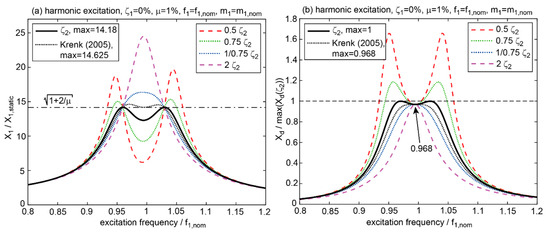
Figure 1.
Normalized responses of (a) primary structure displacement and (b) TMD relative motion for different TMD damping increase factors and for and .
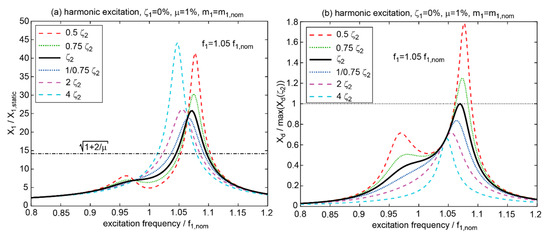
Figure 2.
Normalized responses of (a) primary structure displacement and (b) TMD relative motion for different TMD damping increase factors and for and .
Figure 1 clearly demonstrates that—in the case of precisely known modal parameters—any TMD damping other than the optimum solution (9) increases the primary structure displacement amplitude . Increased TMD damping ( = 1/0.75 ≈ 1.33 and = 2) tends to lock the TMD mass to the primary structure modal mass, whereby the system structure/TMD behaves like a single degree-of-freedom system with increased . Decreased TMD damping does not sufficiently dampen the two resonances of the system structure/TMD, whereby is greater than optimal as well. In addition, the displacement response due to the TMD tuning, according to [13], is included in Figure 1. This tuning leads to a more sound TMD relative motion response with a slope of zero at excitation frequency equal but leads to a greater . In contrast to the case of nominal structural parameters, where nominal TMD damping minimizes , Figure 2 shows that increased TMD damping reduces if the actual modal properties differ from the nominal modal parameters used for TMD design. For the considered case, and , the damping increase factor = 1/0.75 ≈ 1.33 leads to a smaller than that obtained with nominal TMD damping. Hence, increased TMD damping does not reduce the primary structure response if the actual modal parameters agree with those used for TMD design, but increased TMD damping may lead to a smaller primary structure response if the actual modal properties differ from those used for TMD design and if is appropriately selected. The goal of this paper is to provide such damping increase factors, depending on the difference between the actual modal parameters and the nominal modal parameters used for TMD design.
4. Results
4.1. Computations
The normalized displacement response (5) is computed for the excitation frequency range (14) and for the following:
- The considered TMD mass ratios (7);
- The considered TMD damping increase factors (15);
- All combinations of actual modal parameters and (12) and (13).
4.2. Assessment
The computed normalized displacement responses are assessed by their maximum value, which depends on the considered TMD mass ratio, TMD damping increase factor, and the ratio between actual and nominal modal parameters
The results of for the TMD mass ratio = 1% and for the considered combinations of and are depicted in Figure 3a for = 1 and in Figure 3b for = 1.20. It is observed that increased TMD damping mainly reduces the maximum displacement amplitude of the primary structure at large deviations between the actual modal parameters, i.e., eigenfrequency and modal mass, and their nominal values; the numbers of are given at selected points on the surfaces in Figure 3a,b.
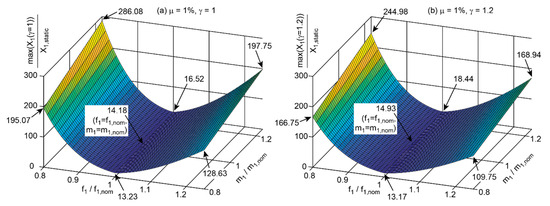
Figure 3.
Maxima of normalized structural displacements as a function of the considered and , for mass ratio = 1%, and for (a) nominal TMD damping ( = 1) and (b) increased TMD damping ( = 1.2).
4.3. Normalization by Results Due to Nominal TMD Damping
To determine for which combinations of and increased TMD damping leads to reduced displacement response of the primary structure, the maximum displacement results, due to the increased TMD damping, are divided by the maximum displacement results due to nominal TMD damping, i.e., the surface depicted in Figure 3b is normalized by the surface plotted in Figure 3a, and this is shown as follows:
where, when (17) shows values smaller than 1, increased TMD damping improves the vibration reduction of the primary structure, and vice versa.
4.4. Discussion of Selected Results
The maximum structural displacements due to increased TMD damping normalized by the maximum structural displacements due to nominal TMD damping (17) are depicted in Figure 4, Figure 5, Figure 6 and Figure 7 for the selected TMD damping increase factors = 1.05, = 1.1, = 1.15, and = 1.2 and for the selected TMD mass ratios = 1% and = 4%. The results for the other computed damping increase factors are not depicted in order to not overload the paper. Surface values with < 1 describe regions where increased TMD damping is beneficial for the actual modal properties and vice versa. Please note that the criterion cannot take the following into consideration:
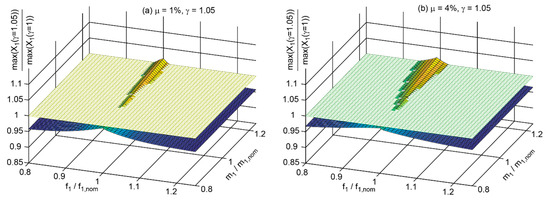
Figure 4.
Maxima of structural displacement with = 1.05 normalized by maxima due to nominal TMD damping ( = 1) as a function of the considered and and for mass ratios (a) = 1 % and (b) = 4%.
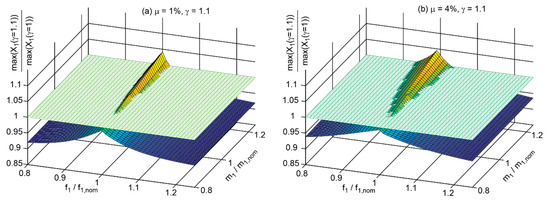
Figure 5.
Maxima of structural displacement with = 1.1 normalized by maxima due to nominal TMD damping ( = 1) as a function of the considered and and for mass ratios (a) = 1% and (b) = 4%.

Figure 6.
Maxima of structural displacement with = 1.15 normalized by maxima due to nominal TMD damping ( = 1) as a function of the considered and and for mass ratios (a) = 1% and (b) = 4%.
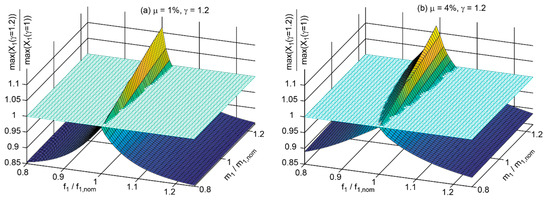
Figure 7.
Maxima of structural displacement with = 1.2 normalized by maxima due to nominal TMD damping ( = 1) as a function of the considered and and for mass ratios (a) = 1% and (b) = 4%.
- The duration for which the actual modal properties deviate from their nominal values, e.g., due to ambient temperature that changes during the day;
- If a severe vibration event occurs during the time when the actual modal properties deviate from their nominal values, e.g., due to a strong wind event.
The results, due to the other considered values of and , are not depicted but are taken into consideration in Section 5 for the discussion of when increased TMD damping is advantageous. To better visualize the regions of reduced displacement amplitudes in the primary structure due to increased TMD damping, the horizontal surface at = 1 is included in Figure 4, Figure 5, Figure 6 and Figure 7 as well. The observation of Figure 4, Figure 5, Figure 6 and Figure 7 points out the following:
- The maximum structural displacement strongly depends on the difference between actual eigenfrequency and nominal eigenfrequency that is used for TMD design. This agrees with the finding that the efficiency of TMDs is strongly frequency tuning sensitive [29,30,31,32].
- Increased TMD damping improves the vibration reduction in the primary structure if the actual eigenfrequency differs much from its nominal value , and vice versa. The greater the value of the selected is, the greater the difference between and must be so that increased TMD damping is beneficial.
- The difference between the actual modal mass and the nominal modal mass that is used for the TMD design shows small influence on the maximum structural displacement. This is good news because, by far, the greatest uncertainty in the TMD design is the value of the modal mass.
5. Beneficial TMD Damping Increase Factors
In the following, beneficial TMD damping increase factors are given, i.e., factors that reduce the maximum displacement response of the primary structure compared to nominal TMD damping. As already mentioned in Section 4, the criterion that is smaller than cannot take into consideration the duration of deviated modal properties of the primary structure and the time instant of a possible vibration event.
Due to the complexity of the investigated problem, the beneficial TMD increase factors depend on TMD mass ratio and the deviations between actual and nominal modal parameters. Therefore, for each TMD mass ratio and for the selected values of (0.8, 0.9, 1, 1/0.9, 1/0.8), three beneficial TMD increase factors with associated frequency ratios are given in Table 1, Table 2, Table 3 and Table 4. The selected three beneficial TMD increase factors are the following:

Table 1.
Beneficial TMD damping increase factors depending on actual modal properties and for TMD mass ratio = 0.5%.

Table 2.
Beneficial TMD damping increase factors depending on actual modal properties and for TMD mass ratio = 1%.

Table 3.
Beneficial TMD damping increase factors depending on actual modal properties and for TMD mass ratio = 4%.

Table 4.
Beneficial TMD damping increase factors depending on actual modal properties and for TMD mass ratio = 10%.
- 1 (no increased TMD damping);
- 1.25 (maximum value considered); and
- 1.125 (half of maximum value considered).
The information provided in these four tables may be used by engineers to decide which TMD damping increase factor may be appropriate for their TMD projects. To demonstrate how the engineer can use the provided table data, one example is given in the following. A TMD for a footbridge with a typical mass ratio of 4% is considered. Hence, the data of Table 3 must be considered. Commonly, the modal mass of the footbridge is estimated from the finite element model and is not measured using accelerometer numbers to ensure high spatial mode shape resolution. As a result, the actual modal mass is not known. Therefore, = 1 is considered. The uncertainty in the eigenfrequency due to temperature effects and life loads is assumed to be ±10%, i.e., the actual eigenfrequency of the first vertical bending mode may vary between 2.2 Hz and 1.8 Hz when the nominal eigenfrequency is 2.0 Hz. For this case, Table 3 shows that the TMD dash pot damper shall be designed for the damping ratio with damping increase factor = 1.125 because may be lower than 0.93 , and may be higher than 1.04 . = 1.25 would not be the appropriate choice because such a great damping increase factor would be appropriate when deviates more from its nominal value, i.e., it is lower than 0.88 and higher than 1.09 .
6. Conclusions
This research investigates if increased TMD damping helps to reduce the maximum structural response when the actual eigenfrequency and modal mass deviate from their nominal values that are used for TMD design. The relevant computations are made for four typical TMD mass ratios, reasonable deviations between actual and nominal modal properties, and harmonic excitation. The general picture is that increased TMD damping is beneficial when the actual eigenfrequency significantly deviates from its nominal value, while the difference between actual and nominal modal mass is of minor relevance. However, the problem is too complex to be able to deduce a simple rule of thumb when increased TMD damping is beneficial. Therefore, the beneficial TMD damping increase factors are given as functions of TMD mass ratio and deviations between actual and nominal modal parameters. These data can be used by engineers for TMD projects.
Funding
This research received no external funding.
Institutional Review Board Statement
Not applicable.
Informed Consent Statement
Not applicable.
Data Availability Statement
The original contributions presented in this study are included in the article. Further inquiries can be directed to the corresponding author.
Acknowledgments
The author gratefully acknowledges the support of Maurer SE, Munich, Germany, Maurer Engineering GmbH, Munich, Germany, and Maurer Switzerland GmbH, Pfaffhausen, Switzerland.
Conflicts of Interest
Author Felix Weber was employed by the company Maurer Switzerland GmbH.
References
- Poon, D.C.K.; Shieh, S.-S.; Joseph, L.M.; Chang, C.-C. Structural Design of Taipei 101, the World’s Tallest Building. In Proceedings of the Council on Tall Buildings and Urban Habitat (CTBUH) 2004 Seoul Conference, Seoul, Republic of Korea, 10–13 October 2004. [Google Scholar]
- Weber, F. Dynamic characteristics of controlled MR-STMDs of Wolgograd Bridge. Smart Mater. Struct. 2013, 22, 095008. [Google Scholar] [CrossRef]
- Den Hartog, J.P. Mechanical Vibrations, 4th ed.; McGraw-Hill: New York, NY, USA, 1956. [Google Scholar]
- Frahm, H. Device for Damping Vibrations of Bodies. U.S. Patent No. 989958, 18 April 1911. pp. 3576–3580. [Google Scholar]
- Brock, J.E. A note on the damped vibration absorber. J. Appl. Mech. ASME 1946, 13, A-284. [Google Scholar] [CrossRef]
- Warburton, G.B.; Ayorinde, E.O. Optimum absorber parameters for simple systems. Earthq. Eng. Struct. Dynam 1980, 8, 197–217. [Google Scholar] [CrossRef]
- Ayorinde, E.O.; Warburton, G.B. Minimizing structural vibrations with absorbers. Earthq. Eng. Struct. Dynam 1980, 8, 219–236. [Google Scholar] [CrossRef]
- Warburton, G.B. Optimum absorber parameters for minimizing vibration response. Earthq. Eng. Struct. Dynam 1981, 9, 251–262. [Google Scholar] [CrossRef]
- Randall, S.E.; Halsted, D.M.; Taylor, D.L. Optimum vibration absorbers for linear damped systems. J. Mech. Des. ASME 1981, 103, 908–913. [Google Scholar] [CrossRef]
- Tsai, H.-C.; Lin, G.-C. Optimum tuned-mass dampers for minimizing steady-state response of support-excited and damped systems. Earthq. Eng. Struct. Dyn. 1993, 22, 957–973. [Google Scholar] [CrossRef]
- Tsai, H.-C.; Lin, G.-C. Explicit formulae for optimum absorber parameters for force-excited and viscously damped system. J. Sound. Vibr 1994, 176, 585–596. [Google Scholar] [CrossRef]
- Asami, T.; Nishihara, O.; Baz, A.M. Analytical solutions to H∞ and H2 optimization of dynamic vibration absorber attached to damped linear systems. J. Vib. Acoust. ASME 2002, 124, 284–295. [Google Scholar] [CrossRef]
- Krenk, S. Frequency Analysis of the Tuned Mass Damper. J. Appl. Mech. 2005, 72, 936–942. [Google Scholar] [CrossRef]
- Bakre, S.V.; Jangid, R.S. Optimum parameters of tuned mass damper for damped main system. Struct. Control. Health Monit. 2007, 14, 448–470. [Google Scholar] [CrossRef]
- Hoang, N.; Fujino, Y.; Warnitchai, P. Optimal tuned mass damper for seismic applications and practical design formulas. Eng. Struct. 2008, 30, 707–715. [Google Scholar] [CrossRef]
- Krenk, S.; Høgsberg, J. Tuned mass absorbers on damped structures under random load. Probabilistic Eng. Mech. 2008, 23, 408–415. [Google Scholar] [CrossRef]
- Leung, A.Y.T.; Zhang, H. Particle swarm optimization of tuned mass dampers. Eng. Struct. 2009, 31, 715–728. [Google Scholar] [CrossRef]
- Salvi, J.; Rizzi, E. Minimax optimization of Tuned Mass Dampers under seismic excitation. In Proceedings of the 8th International Conference on Structural Dynamics (EURODYN 2011), Leuven, Belgium, 4–7 July 2011. [Google Scholar]
- Salvi, J.; Rizzi, E. A numerical approach towards best tuning of Tuned Mass Dampers. In Proceedings of the International Conference on Noise and Vibration Engineering, ISMA 2012-USD2012, Leuven, Belgium, 17–19 September 2012. [Google Scholar]
- Sohn, H.; Dzwonczyk, M.; Straser, E.G.; Kiremidjian, A.S.; Law, K.H.; Meng, T. An experimental study of temperature effect on modal parameters of the Alamosa Canyon Bridge. Earthq. Engng. Struct. Dyn. 1999, 28, 879–897. [Google Scholar] [CrossRef]
- Peeters, B.; Maeck, J.; De Roeck, G. Vibration-based damage detection in civil engineering: Excitation sources and temperature effects. Smart Mater. Struct. 2001, 10, 518–527. [Google Scholar] [CrossRef]
- Fan, K.Q.; Ni, Y.; Gao, Z.M. Research on temperature influences in long-span bridge eigenfrequencies identification. China J. Highw. Transp. 2006, 19, 67–73. [Google Scholar]
- Cantieni, R. Health monitoring of civil engineering structures—What we can learn from experience. In Proceedings of the 3rd IALCCE, International Symposium on Live-Cycle Civil Engineering, Vienna, Austria, 3–6 October 2012. [Google Scholar]
- Sun, L.M.; Zhou, Y.; Li, X.L. Correlation Study on Modal Frequency and Temperature Effects of a Cable-Stayed Bridge Model. Adv. Mater. Res. 2012, 446–449, 3264–3272. [Google Scholar] [CrossRef]
- Cantieni, R. One-Year Monitoring of a Historic Bell Tower. Key Eng. Mater. 2014, 628, 73–78. [Google Scholar] [CrossRef]
- Sun, L.; Zhou, Y.; Min, Z. Experimental Study on the Effect of Temperature on Modal Frequencies of Bridges. Int. J. Struct. Stab. Dyn. 2018, 18, 1850155. [Google Scholar] [CrossRef]
- Weber, F.; Baader, J.; Bitterli, K.; Rufer, P. Actively controlled vibration absorbers for long span belt conveyor bridges. Stahlbau 2015, 84, 246–251. [Google Scholar] [CrossRef]
- Nagarajaiah, S.; Sonmez, E. Structures with semiactive variable stiffness single/multiple tuned mass dampers. J. Struct. Eng. 2007, 133, 67–77. [Google Scholar] [CrossRef]
- Casado, C.M.; Poncela, A.V.; Lorenzana, A. Adaptive tuned mass damper for the construction of concrete piers. Struct. Eng. Int. 2007, 17, 252–255. [Google Scholar] [CrossRef]
- Hoang, N.; Zhang, N.; Du, H. An adaptive tunable vibration absorber using a new magnetorheological elastomer for vehicular powertrain transient vibration reduction. Smart Mater. Struct. 2011, 20, 015019. [Google Scholar] [CrossRef]
- Kim, S.M.; Wang, S.; Brennan, M.J. Optimal and robust modal control of a flexible structure using an active dynamic vibration absorber. Smart Mater. Struct. 2011, 20, 045003. [Google Scholar] [CrossRef]
- Weber, F. Semi-active vibration absorber based on real-time controlled MR damper. Mech. Syst. Signal Process. 2014, 46, 272–288. [Google Scholar] [CrossRef]
Disclaimer/Publisher’s Note: The statements, opinions and data contained in all publications are solely those of the individual author(s) and contributor(s) and not of MDPI and/or the editor(s). MDPI and/or the editor(s) disclaim responsibility for any injury to people or property resulting from any ideas, methods, instructions or products referred to in the content. |
© 2025 by the author. Licensee MDPI, Basel, Switzerland. This article is an open access article distributed under the terms and conditions of the Creative Commons Attribution (CC BY) license (https://creativecommons.org/licenses/by/4.0/).